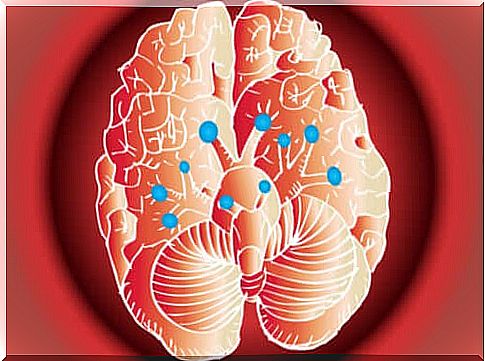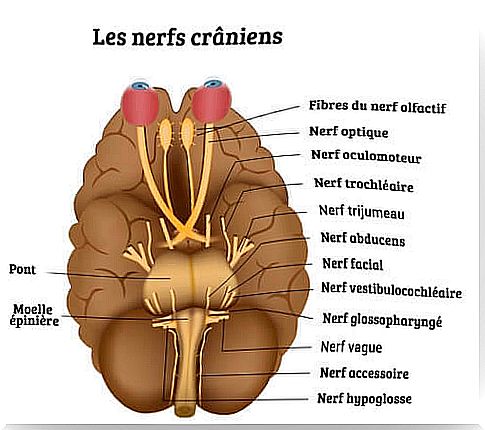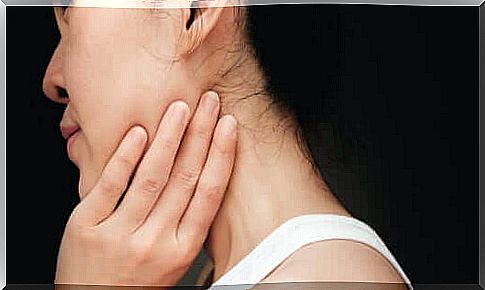The 12 Pairs Of Cranial Nerves And Their Functions

The complexity of the nervous system is great. Its multiple connections make this system one of the most important in our body. In this article, we’ll talk about several of its most important pathways: the cranial nerve pairs.
Pairs of cranial nerves start from the base of the skull and reach their destination areas through holes distributed throughout it. Thus, these nerves communicate with the peripheral areas. Their name comes from the fact that there is a nerve on both sides of the brain. Then there are twelve nerves in the right hemisphere and twelve in the left hemisphere.
Classification of cranial nerve pairs
Pairs of cranial nerves can be classified in different ways:
- According to their function:
- Cranial motor nerves: there are the cranial nerves related to eye movements: three, four and five; and the cranial nerves related to the movements of the tongue and neck: ten and twelve
- Sensitive cranial pairs : one, two and eight
- Mixed cranial nerves : five, seven, nine and ten
- Parasympathetic cranial pairs : three, seven
- Depending on their position: those above the brainstem (pairs one and two); those above the brainstem (pairs three and four); those near the bridge (pairs five, six, seven and eight); those located in the lower part of the medulla oblongata (pairs nine, ten, eleven and twelve).
According to Bear, Connors and Paradiso, authors of the book Neuroscience. Exploring the brain, it would seem that the first two cranial pairs are part of the central nervous system and the others are like the spinal nerves, “ in the sense that they contain axons of the peripheral nervous system ”. However, each nerve has fibers that can perform a variety of functions.
The pairs of cranial nerves and their functions

Pair number one
Types of axons : sensory specials
It is the shortest cranial nerve because its target area is close to the area where it originated in the brain. It is also called the olfactory nerve. In addition, as its other name suggests, it is responsible for carrying nervous information related to smell.
Pair number two
Types of axons : sensory specials
It comes from the diencephalon. And, like the previous pair, it has afferent fibers. To put it more simply, these fibers carry nerve impulses from the sensory organs to the central nervous system. The function of this pair is to transmit visual information.
Pair number 3
Types of axons: somatic motors and visceral motors
This nerve is called in two other ways: oculomotor nerve or common ocular motor. It is responsible for the movement of the eyes and eyelids. In addition, it manages the parasympathetic control of the size of the pupil.
Pair number four
Types of axons : somatic motors
The fourth pair comes from the midbrain. It is called both the trochlear nerve and the pathetic nerve. It is also responsible for the movement of the eyes. It specifically sends signals to the upper oblique muscle of the eye.
Pair number five
Types of axons: sensory somatic sensory and somatic motor
Known as the trigeminal nerve. It performs motor and sensory functions. At the motor level, it sends commands to the muscles responsible for chewing and at the sensory level. In addition, it collects tactile information, pain, proprioception of the mouth and face.
Pair number six
Types of axons : somatic motors
It is called the abducens nerve. It takes care of the movements of the eye, that is to say, it is he who moves the eye from side to side. Incredible, isn’t it?
Pair number seven
Types of axons: sensory somatic sensory and somatic motor
Also known as the facial pair. This pair deals with the movements of the muscles of facial expression. In addition, it is also responsible for the sense of taste in the previous two-thirds of the tongue. It also sends commands to the tear and salivary glands.
Pair number eight
Types of axons: sensory specials
It is the vestibulocochlear nerve. It is responsible for the sense of hearing and balance. Therefore, he receives information about what we hear and what position we find ourselves in.
Pair number nine
Types of axons: somatic motors, visceral motors, special sensory and visceral motors
Called glossopharyngeal nerve. It’s a mixed nerve. From its name it is quite easy to deduce its functions:
- Movement of throat muscles
- Parasympathetic control of the salivary glands
- Detection of changes in blood pressure in the aorta
- Sense of taste in the posterior third of the tongue

Pair number ten
Types of axons: visceral motors
This is called the vagus nerve. It is responsible for the parasympathetic control of the heart, lungs and abdominal organs. In addition, it supports the sensation of visceral pain, the movement of the muscles of the throat and receives taste information.
Pair number eleven
Types of axons : somatic motors
This is the accessory spinal nerve. It takes care of the movements of the muscles of the throat and neck.
Pair number twelve
Types of axons: somatic motors
Called hypoglossus. Participates in the action of swallowing. In addition, it is responsible for the movement of the tongue, working in conjunction with cranial pairs nine and ten. Thanks to this pair, swallowing is carried out optimally.
Now you should know that any damage to the cranial pairs can be a problem for our survival or for the functioning of our organism. Also, it can cause significant neurological damage. We hope that we have made this essential part of our body a little better known to you.









